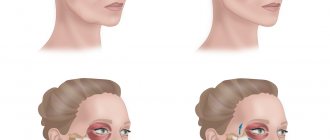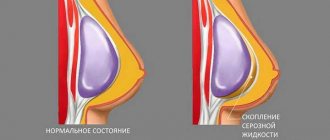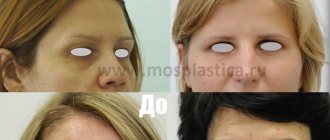Lip correction with filler is certainly one of the most popular requests from cosmetologist patients. You can add volume, correct asymmetry, and balance the proportions of your lips with a quick, minimally invasive procedure that does not require long-term recovery. But after injections of filler into the lip area, patients often report to the doctor about undesirable effects, such as swelling, sensitivity, erythema, changes in skin color, the presence of lumps, etc. They can occur immediately or some time after the injection of the drugs. The article estet-portal.com will discuss methods prevention and treatment immediate, early and late complications of lip correction with fillers.
- How to prevent complications after lip filler injections
- Possible adverse events after lip correction with fillers
- Immediate complications of lip contouring
- Early complications of injection lip correction
- Late complications of lip filler
Severe pain after the procedure
Leading cosmetology companies claim that fillers do not harm the body; unscrupulous clinics are to blame. It is not true. Despite the frequent use of anesthetic gel, the sensations from the procedure can be unpleasant.
This is especially noticeable when piercing a sensitive area of the lips or when a specialist uses a fan puncture (the needle is inserted subcutaneously, and the sharpest part moves clockwise). Even if clients have an extremely low pain threshold, they will still experience pain and tingling.
This problem can be solved with local anesthetic cocktails. This is carried out by Juvederm and Belotero. According to recent tests, pain is reduced by 50 percent. In addition, the manufacturer claims that such fillers do not cause fluid accumulation as intensely as others when injected into the lips.
Many patients fear serious complications that lidocaine causes. This information was widely publicized in the media and was confirmed by various studies. However, these problems were caused by an overdose of anesthetic. Fillers contain a minimal concentration of an anesthetic substance; it can be administered even to people with heart problems.
Problems and solutions for lip correction
However, leading clinics still give preference to certain drugs: Restylane, Surgiderm, Juvederm, Teosyal, Perlane, Princess, Belotero. The choice of filler is determined by the doctor and depends on the goals - one or another gel solves its problem. For example, lip augmentation with Restylane Lipp filler is quite popular. Juvederm and Surgiderm will provide a clear contour due to their higher content of hyaluronic acid. Often, the doctor uses variations of the same filler of different densities in order to achieve the desired result. An example is this combination - a dense gel for contour and a softer filler to enlarge the lips and make them look natural. The last factor is very important and it depends on professionalism in the selection and administration of drugs.
Bruising and swelling after contouring with fillers
From the point of view of medicine and world cosmetologists, there is nothing dangerous in the appearance of hematomas and swelling after the introduction of cocktails. Tissue injury is an expected occurrence, although the client can always insure himself against complications. The first is to make an appointment with a cosmetologist, and the second is to take pharmacological medications that strengthen blood vessels a week before the session.
When cocktails, in addition to fillers, include non-sulfonated glycosaminoglycan, visible stagnation of liquid may appear, since these components actively absorb and retain water. This situation cannot be called a complication and, basically, it normalizes in a few days without intervention. The problem may worsen in the area around the eyes if more active substances are injected than the skin can absorb. Therefore, cosmetologists often refuse to perform contouring in this area, offering clients alternative procedures. If lymph outflow is impaired, it is recommended to undergo a massage course.
Possible adverse events after lip correction with fillers
In the vast majority of cases, patients tolerate injection lip correction well. Patients report predominantly mild discomfort during the procedure. Expected side effects may occur after receiving any dermal filler . During the consultation, the physician should warn the patient about possible adverse events associated with the injection procedure, which may occur immediately or over time. Depending on this factor, complications are distinguished:
- immediate;
- early;
- late (delayed).
Inflammation at the puncture site
Inflammation cannot be considered a side effect. Despite the complete biological compatibility of non-sulfonated glycosaminoglycan, immediately after its administration, the internal organs activate their classic protective mechanism against “external irritants”. After a few days, all biological processes are normalized, and inflammation quickly disappears. If this doesn't happen:
- During the puncture, an infection entered the body. This does not mean that the cosmetologist did something wrong; maybe the injections only “activated” the viruses that had entered the tissue a few days before the injections;
- The woman was diagnosed with autoimmune diseases, which, in response to the absorption of the cocktail, began to inflame the treated area.
These two points are diametrically opposed. In the first case, the woman must take pharmacological agents, in the second - steroids, which dampens the effect of the local immune reaction. If steroids are injected into an area with a bacterial infection, the situation will only worsen, with the likely formation of massive suppurations and further scarring. Therefore, it is extremely dangerous to self-medicate; you need to urgently make an appointment with a specialist for qualified advice.
Operating principle of cryodestruction
The procedure is performed using special equipment (cryodestructor) or liquid nitrogen. When using the hardware method, the tip of the applicator is pressed against the required area, after which it is cooled to a temperature of -180-190 degrees Celsius. When using liquid nitrogen, a cotton swab is soaked in it, and then simply applied to the damaged tissue for a short period of time (no more than 2-3 minutes).
The procedure involves instant cooling of tissues due to exposure to ultra-low temperatures. As a result, the intracellular and intercellular fluid freezes, the vital activity of cells is disrupted, protoplasm stops and microcirculation in the pathological tissue is disrupted. Tissue destruction occurs. After cryodestruction, the destroyed tissues are gradually replaced with healthy ones.
Tissue compaction, the appearance of neoplasms
If hard lumps appear at the injection site, this is not always a side effect. This reaction can easily be explained by the introduction of a concentrated drug while it is not yet completely distributed throughout the layers of the skin. During the puncture, the vascular wall could be damaged, resulting in hemorrhage and an accumulation of blood and lymph under the skin (do not be upset here, the situation will return to normal in a few days).
Most popular: How to choose a foundation based on skin color and type
It is worse if the cause of the compaction is the proliferation of connective tissue. This phenomenon is diagnosed in many women and is an indicator of a correctly performed procedure. It signals the formation of new fibrillar protein. However, sometimes, the proliferation of connective tissue occurs to such an extent that it can be seen with the naked eye.
The specialist is obliged to prevent this complication by choosing a drug and dose that is suitable for the woman. If this is not done, you need to be prepared for long-term sequential rehabilitation: hardware and manipulation procedures that reduce the bumps. In rare cases, anti-scar medications are prescribed.
Problems after hyaluronic acid
The most popular material used for facial rejuvenation is still hyaluronic acid. Despite advertising assurances about its complete safety, cosmetologists themselves list a number of problems that may arise after the procedure for administering the drug:
- Pain during injections. This, in principle, is a normal reaction of the body; it does not have any serious consequences for the body, but it does cause severe discomfort. Often, specialists perform injections with thick needles, but this is not their whim, but a necessity - hyaluronic acid may contain tiny grainy inclusions that will simply clog a needle that is too thin.
- Swelling and hyperemia of the skin at the injection site. It is unlikely that anyone will escape these consequences, since they relate to the body’s normal reaction to aggressive irritation from the outside. Such consequences do not require any therapy; the patient’s appearance is restored within a maximum of 5 days.
- Hematomas are small and extensive. They do not pose a health hazard, but do not allow the patient to quickly return to their usual rhythm of life. Bruises disappear in a maximum of 10 days; recovery can be accelerated by applying ointment containing bodyaga or heparin to problem areas.
- Necrotic processes at the injection site. If they are clearly localized and are not accompanied by pain, then you just need to wait 5 - 10 days. As a rule, during this time all symptoms of punctate necrosis disappear.
But if the blue/purple color of the skin is not localized, pain appears in this area, and the general condition worsens significantly, then you will need to undergo a full therapeutic course aimed at stopping the inflammatory process and preventing infection of the injection site.
Skin necrosis
- Clear visibility of the injected hyaluronic acid under the skin. We are talking about a violation of the technology of the procedure - the drug is administered in large quantities or too superficially. Lumps/bumps/bumps will be visible on the face.
Complications after lip hematoma contouring
Blue discoloration in this area is normal after injections and should disappear after a few days. If an infection gets into the puncture area and proper treatment is not carried out, dense nodes of connective tissue may appear that appear in the area affected by bacteria. You can get rid of them only through surgery.
Remote hypersensitivity was also diagnosed in some patients. This reaction appears on the lips several weeks or months after the introduction of cocktails. It is very difficult to prevent formation, but the chances of its development are insignificant; a woman would rather win the lottery than experience such an unpleasant consequence.
Reduced blood supply to the treated area after contouring is the most dangerous, although quite rare, complication. Develops in the case of:
- Using a large volume of a substance that was injected as close as possible to the vessels. Excess could compress the elastic tubular formations and impede blood flow. Often the problem is aggravated by the accumulation of fluid in the tissues;
- The cocktail entered the lumen of the tubular formations. In this case, blood vessels may become blocked and blood flow may slow down.
The problem develops in the area with maximum blood flow: the nose and lips. This explains complications after contour plastic surgery of nasolabial folds. It is difficult not to pay attention to them: the area will hurt unbearably, white spots with a bright scarlet or blue edge will appear. This reaction occurs as a result of blood overflowing the nearby elastic tubes.
Western media described situations where blood clots from beauty cocktails reached the eye arteries, which led to complete or partial blindness.
If a woman notices any of these symptoms, she should immediately seek medical help. Doctors use classic treatment tactics - they introduce various enzymes that quickly remove fillers and other active substances. If you delay even a few hours, the likelihood of tissue death increases: cells that are deprived of nutrients die and infect the body with an infection. In this case, only surgical intervention will be effective, after which scars may form on the face.
Lip contouring to correct age-related changes
To correct age-related changes in the lips, the contour plastic method is more suitable. During the aging process, the synthesis of glycosaminoglycans, natural polymers that give and maintain elasticity and volume to the skin, decreases. Therefore, over the years, lips lose their elasticity and shape, and the skin around them becomes covered with a network of wrinkles. Contour plastic surgery - injection technique Correction of thin, lost volume or asymmetrical lips is possible with the help of hyaluronic acid. This method is called contour plastic and has a number of advantages:
- the ability to get the desired result in just one procedure;
- if indicated, the technique can be used for young patients;
- speed of implementation, lack of preparatory and rehabilitation period;
- duration of retention of the result;
- safety of the procedure.
Contour plastic surgery is a non-surgical injection technique. To carry out the procedure, biodegradable fillers based on hyaluronic acid are used. It is this substance that is natural for our body, since it is present in connective tissue, but over time its amount is noticeably reduced.
Allergic rashes
The complication is extremely rare; pharmacists themselves call it “personal intolerance.” The exact number of such reactions is still unknown, because pharmacological giants are not interested in introducing these statistics. According to surveys, this problem affects every 2000 patients, which gives hope for a quality product. For non-sulfonated glycosaminoglycan the figure will be even lower, and the most dangerous in this matter is collagen. An allergic reaction to it occurs in every hundredth patient.
To avoid this, as well as to prevent some side effects, a skin test is usually performed before the injection - a small dose of active substances is precisely injected to diagnose and record the body's reaction. If everything goes according to plan, you can carry out a full impact. This test is not mandatory, but all cosmetologists conduct it for the safety of themselves and their clients.
An allergic reaction after the procedure can manifest itself in different ways - from minimal red spots and swelling of the skin to more dangerous processes that resemble a severe cold (the thermometer readings increase, the throat swells and begins to hurt). Symptoms can be relieved with corticosteroids or antihistamine cream.
Most popular: Home remedies to remove white spots under eyes
Necrosis of the palate after anesthesia
Local anesthesia is used during most dental procedures. But the anesthesia procedure itself may be associated with potential complications such as tissue necrosis, infection, trismus, prolonged pain, needle fracture, and paresthesia.
The palate area is often the location of many soft tissue lesions due to the specific nature of its rich vascularization. On the other hand, a huge number of large and small vessels allow the palate to heal faster and maintain a stable shape, despite local irritants.
When performing anesthesia in the palate, the physician must consider the influence of many factors, especially in patients who are taking medications aimed at minimizing the effect of bone loss due to osteoporosis or various forms of malignancy. Such drugs are bisphosphonates, which affect the process of bone remodeling by inhibiting osteoclast activity, but can also cause local circulatory problems. Changes in blood vessel activity are also observed in patients with diabetes and in patients undergoing radiation therapy. Spontaneous necrosis in the palate can be caused by bacterial, fungal or viral infections. During anesthesia, trauma from a needle or anesthetic solution can cause swelling of the surrounding tissue, which in turn can lead to reactivation of the latent virus.
Clinical case
The patient came to the dental clinic due to acute pain in the area of the right upper incisor. The tooth was very mobile and there was significant swelling on the vestibular side (photo 1).
Photo 1
Medical records indicated that the patient had undergone restorations and ceramic crowns approximately 40 days ago (Figure 2). Considering the presence of pain and severe tooth mobility, it was inappropriate to conduct a tooth vitality test.
Photo 2
Photos 3 and 4 showed significant bone loss. In order to check the vitality of the tooth, the tooth was prepared through the crown from the palatal side. During this manipulation, the patient immediately responded to the intervention, which indicated that the tooth remained vital (photo 5). The radiograph showed signs of bone tissue destruction on the palatal side, but the presence of unaffected bone areas was also noted in the periapical region. Further analysis of the medical history revealed that the patient had received multiple anesthetic injections in the palate.
Photo 3 - 5
During the analysis of CBCT sections (photos 6-7), it was possible to visualize the bone defect on the palatal and vestibular sides while maintaining healthy bone tissue in the periapical zone.
Photo 6
Photo 7
In cases of bone necrosis, it is recommended to avoid further manipulations and ensure that the infectious process is stopped in order to stop the progressive destruction of the bone. The patient was advised to take Dalacin C 300 mg twice daily and Metronidazole 500 mg twice daily for ten days.
The patient was observed for five days, during which it was noted that the tooth became more stable and the vestibular swelling decreased. After two weeks, the tooth was completely stabilized. A month later, the patient reported strange sensations in the palate: as if something was coming out of the soft tissue of the palate (photo 8). Under microscopic control, the presence of necrotic bone tissue, which was rejected, was visualized. The problem area was carefully cleaned, and the sequestered bone was removed piece by piece (Photo 9). After this, the intervention area was washed with chlorhexidine.
Photo 8
Photo 9
In total, it took about 45 days for the tooth to achieve complete stabilization. After this, the stability of this unit of the dentition was reconfirmed. On radiographs after 6 months, signs of bone tissue restoration in the area of the defect were visualized (photos 10-11).
Photo 10
Photo 11
Conclusion
Soft tissues in the palate are more sensitive to various local complications. Changes in the structure of the palatal mucosa can be caused by ischemia, osmotic pressure, physical pressure during injection, the irritant effect of vasoconstrictors, and even needle trauma. Typically, the structure of anesthetics uses the vasoconstrictor epinephrine at a concentration of 1:50,000-1:200,000, which reduces the systemic toxicity of anesthetics and increases the duration of anesthesia. Large concentrations of vasoconstrictor 1:50,000 with frequent injection of anesthetic into the same area can cause certain complications. By stimulating vascular receptors, vasoconstrictors can cause prolonged ischemia, which, in turn, can provoke the development of a trophic ulcer at the injection site. Necrosis of bone tissue as a result of anesthesia can be associated with the influence of many systemic and local factors: diabetes, which complicates the tissue healing process; bacterial infections, malnutrition, poor oral hygiene. All this can provoke not only bone sequestration, but even tooth loss. Viral infections such as chickenpox, the causative agent of which is located in the dorsal roots and ganglia of the cranial nerves, can disrupt the innervation of the periosteum, which, in turn, changes its blood supply and leads to necrosis. Taking systemic drugs, such as bisphosphonates, affects bone remodeling by inhibiting osteoclastic activity, while also changing the blood supply to the jaw bone.
Necrosis of bone tissue is also possible, caused by the effect of radiotherapy, as a result of which the tissues become hypovascularized, suffer from a decrease in cell size and hypoxia. These changes are especially critical for the lower jaw compared to the upper jaw.
Treatment of osteonecrosis is carried out using antibiotics such as penicillin and metronidazole, with mandatory mechanical cleaning of sequestered areas and washing of affected areas with antibacterial solutions. Also, patients with osteonecrosis are recommended to improve nutrition, increase the level of oral hygiene and carry out complete sanitation.
In order to minimize the risk of complications associated with the anesthesia procedure, it is recommended:
- Ensure slow deposition of local anesthetic without excessive pressure;
- Take into account the specific anatomy of the palate;
- Consider the dose of anesthetic administered;
- Do not perform multiple injections in the same place during one procedure.
Authors: Drs Pamela Kassabian, Valerie Batrouni, Edgard Jabbour, Philippe Sleiman (Lebanon)
The gel protrudes and migrates
If the cocktail is injected too superficially, its visual outline is often noted - in this case, the gel begins to bulge outward, and the skin becomes covered with tubercles. The gel can often be seen with the naked eye - it resembles gray spots with a blue or purple tint.
This side effect does not harm the patient’s health, but from an aesthetic point of view it looks very unsightly. In order for the tissues to recover, it is necessary to wait several months (during this time the active substances will be absorbed), or they are removed with enzymes of plant origin.
If the injections were injected too deeply, the gel may “move” from the affected area to the adjacent one, disrupting facial expressions. To prevent this phenomenon, it is necessary to prematurely confirm the qualifications of a specialist. A professional will not allow such errors, because he values his reputation and the aesthetics of his work.
However, displacement does not always occur as a result of unskilled execution - sometimes it happens when the patient does not follow the recommendations and massages the affected area. In rare cases, the anatomical feature of the soft tissues is to blame (over the years, various cavities may appear in them, into which a beauty cocktail can easily “leak”).
This problem can be eliminated with additional injections, but if there is no asymmetry, you need to wait a little for absorption, and after some time take into account the bitter experience.
For decades now, silicone and biopolymer cocktails have been used in the world of cosmetology, which are prohibited in all developed countries. But despite this, even today there are women who want to inject themselves with these injections. They are seduced by low costs and results that will last “forever.”
Massive formations, due to the movement of acrylic-based gel, lead to dire consequences.
Drugs that are not absorbed will, after some time, shift relative to the initial injection, often significantly disfiguring the facial contour. This reaction is possible even if the punctures were carried out according to all requirements. There are several reasons for this - active facial expressions and tissue exposure, ptosis, age-related cell deformations, etc. Over the years, or after a few months, the gel will clog the vessels responsible for blood flow and the situation can be fatal.
Frequent friends of such injections are chronic infectious and inflammatory processes.
The main problem of complications is that it is very difficult to remove such gels from the body: the doctor must be sufficiently qualified and carry out not one, but more often, several surgical interventions, which carry certain risks and consequences. The latter manifest themselves in the form of scars, cicatrices and the growth of connective tissue, especially those areas where the gels were previously affected. Therefore, there is only one recipe for this complication: administer modern biological drugs.
Possible complications: symptoms and consequences management
A change in skin color immediately after filler injection indicates vascular ischemia. Symptoms of arterial or venous occlusion, which can lead to skin necrosis, include discoloration or darkening of the skin (to a blue-gray hue), ecchymosis, reticular erythema, and severe pain at the injection site.
In cases of vascular occlusion or ensuing necrosis, the main goal is to stimulate blood flow in the affected area. The following methods can be used for this:
- immediate application of a warm compress,
- massage the affected area to dilate blood vessels and disperse the injected drug,
- taking aspirin,
- the use of external drugs that stimulate vasodilation,
- injection of hyaluronidase (in case of injection of hyaluronic acid fillers),
- injection of corticosteroids (anti-inflammatory/immunomodulatory),
- taking antibiotics,
- taking antiviral drugs (in case of threat of necrosis in the perioral area).
It is also possible to use hyperbaric oxygen therapy and laser procedures 3 months after the injection of the filler.
Cases of retinal artery occlusion are extremely rare and very dangerous. Symptoms of possible vision loss are sharp pain in the area of the affected eye immediately after filler injection, blurred vision, ptosis, headache, dizziness, nausea, and ophthalmoplegia.
Usually, in the case of retinal artery occlusion, vision loss is irreversible. The best way to prevent this extremely undesirable phenomenon is to avoid dangerous areas when injecting fillers, especially in the area of the glabella, forehead and upper part of the nasolabial folds.
Principles for safe injection of fillers in hazardous areas
In rare, but still possible, cases of vascular occlusion and subsequent necrosis and/or loss of vision after injection of fillers, emergency medical measures are essential. Sudden sharp pain and/or skin discoloration are warning signs of vascular occlusion, ischemia, and impending necrosis. To reduce the likelihood of undesirable consequences of this nature, it is recommended to follow the following rules:
- inject filler in small doses,
- do not use anesthesia (including drugs containing epinephrine) near vascular bundles, so as not to cause vascular spasm,
- avoid the use of epinephrine to be able to quickly identify the cause of skin discoloration,
- use a small needle so that the filler enters the tissue in minimal doses,
- use biodegradable fillers (for example, hyaluronidase stimulates the rapid breakdown of hyaluronic acid fillers),
- when injecting filler, use the finger of your non-dominant hand to block the adjacent blood vessel,
- inject filler into the upper and middle layers,
- assess the level of pain of the procedure,
- monitor possible changes in skin color,
- If non-biodegradable fillers are used, administer them in small doses and take into account their high viscosity.
To prevent such a complication as vascular occlusion, I propose to use a simple and effective technique - an aspiration test: after inserting the needle into the correction zone and before starting to deliver the drug, it is necessary to perform a slight reverse movement of the syringe piston. If there is no blood, you can start administering the drug. This test allows you to exclude the drug from entering the vascular bed.











